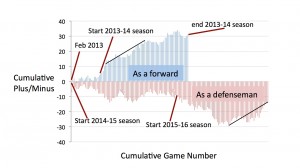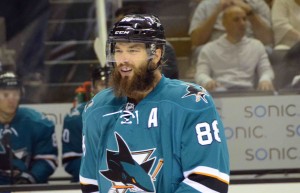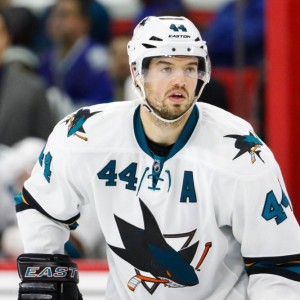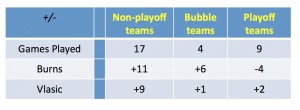For about season and a half, San Jose Sharks defenseman Brent Burns enabled the controversy about his position. Burns, the most interesting player in hockey, played 93 games as a forward in 2013 and 2014. In those games, he was a plus-31. Sharks general manager Doug Wilson moved Burns back to defense for the 2014-15 season and that season, he dipped to a minus-9. In the first part of the 2015-16 season, the trend continued, it even worsened. After the first game of 2016, Burns reached a nadir at minus-15.

It added up to a minus-24 over a period of 119 games. Quite a contrast from the plus-31 he had achieved as a forward. Wilson’s gamble was looking very shaky indeed.
Then Burns began a turnaround. Many turnarounds are gradual and subtle. Burns has never been subtle. Over the next four games, Burns would go plus-5 and the Sharks started looking like a completely different team.
Burns turning point in early January would prove the team’s turning point as well. After a particularly dreadful loss against Winnipeg to start the calendar year, the Sharks would refocus and capture points in all but one game during the rest of the month. In February, the Sharks would collect points in all but four games. While not the hottest team in the league, the Sharks quickly surged up the standings and positioned themselves solidly into a playoff spot.
That the Burns turnaround coincided with the team’s turnaround is not a coincidence. Burns leads the team, by a huge amount, in ice time. His plus-minus numbers stayed relatively flat until leap year. On February 29, Burns began a five game run in which he would go plus-10. By the time his 30th birthday rolled around on March 9, Burns’ plus-minus was even for the season. His streak had him at a remarkable plus-15 in just 29 games.

Simple Enough
The reasons for the turnaround are simple enough. He is playing much better. There is genuine improvement in his game. Most criticisms of Burns were centered around his struggles on defense, particularly his tendency to engage in high-risk, low-reward plays. Things like missed assignments, missed stretch passes that turned into icing and unwise pinches have all dropped off considerably in Burns’ turnaround. During his turnaround, the rate at which goals are scored against the Sharks with Burns on the ice (at even strength) has been cut nearly in half.

Burns’ offensive contributions have also improved considerably. He appears to be passing the puck better. Burns has a remarkable shot. Instead of simply trying to laser the puck past goalies from long-range, Burns game has evolved. There are more shots intended to create tips and redirects. As his repertoire has expanded, the ability for teams to defend against him has diminished.
In the article I wrote on January 6, I noted Burns had been on the ice for fewer 5-on-5 offensive goals than Brenden Dillon. Dillon is a third pairing defenseman with a limited offensive skill set. In the season’s first 37 games, the Sharks had just 20 5-on-5 goals with Burns on the ice. In the 29 games since, the Sharks have 32 5-on-5 goals with Burns on the ice. The team’s scoring rate with Burns on the ice doubled. At this point, only Vlasic has been on the ice for more Sharks 5-on-5 goals than Burns among Sharks defensemen, and it is close.

There are other symbiotic contributors to this turnaround. A healthy Logan Couture has helped the Sharks a lot. So has improved goaltending, starter Martin Jones has a .929 save percentage during this run (he has been especially tough at even strength, 1/3 of scoring against him happened on the penalty kill). Player familiarity with new coach Peter DeBoer’s system is also having a positive effect. The contributors I’ve mentioned are not the cause of Burns’ turnaround, but they have amplified the effects.
The combination of Burns unusual skill set with a new coach and new system seems to have found a sweet spot. Burns aggression remains, but he chooses his spots better. Helping matters further, the team’s forwards now do a better job of fulfilling Burns defensive responsibilities when he goes into his offensive mode. What was once chaos is now much more systematic. And effective.
The Caveat
On the Sharks, the tougher defensive assignments are typically doled out to the defensive pairing of Marc-Edouard Vlasic and Justin Braun. Braun and Vlasic take roughly 40% more face-offs in the defensive zone than in the offensive zone, while Burns takes 5% more face-offs in the offensive zone relative to the defensive zone.

Vlasic and Braun have tipped the ice in the Sharks favor against opponent’s top-end players (+12 and +9 respectively over the same timeframe). Burns has the advantage of playing other teams secondary players more often.
Against second tier competition on second and third tier teams, Burns is a complete mismatch. He dominates. This is not intended as faint praise; successful teams in almost every sport exploit their favorable matchups.
Against teams with talented depth, Burns has not dominated. As of now, there are seven teams that are essentially locked into playoff spots in the West. This includes the Sharks along with six other closely bunched competitors: Blackhawks, Stars, Predators, Blues, Ducks and Kings. In seven games against these six high-end competitors (the Sharks have played them all) during the streak, Burns is a suspect minus-5.
The table below makes it clear. Against teams that are essentially out of the payoff hunt, Burns is tearing it up. Against the playoff bubble teams, it is the same story. But against the teams that will definitely join the Sharks in the postseason, the result is different.

Back to the streak mentioned earlier with Burns going plus-10 in five games. Those games came against Edmonton, Calgary, Montreal and a pair against Vancouver. All teams with records that are in the league’s bottom ten.
Against lesser players on lesser teams, Burns is taking no prisoners. However, for him to take the final step, he needs his play to hold up against better teams. The teams where the second and third line talent is not a major drop-off from the top line.
I expect the problematic Burns of the first 119 games following his return to defenseman is gone for good. His overall game is better in many ways, including the way he integrates his talents with the team’s schemes.
Over the final 15 games of this regular season, the Sharks will play just four games against teams locked into playoffs spots in the West. They will play three locked-in (or close to it) teams from the East with only one game against a playoff bubble team. These games should give people an idea if Burns is taking that important final step before the playoffs.
Zeke’s Notes
As always, the plus-minus statistic comes with its own share of critics and caveats. Many are of these cautions and criticisms are justified. In my work, I see if plus-minus agrees with my eyeballs. If it doesn’t, I will say so. In the case of Burns, plus-minus has reasonably represented his play across the time span covered. In good times and bad.
The Sharks will host the Capitals on Saturday night. This matchup forecasts to be a good one on many levels. Still, I miss the mano-a-mano matchup from seasons past between Alexander Ovechkin and former Shark Douglas Murray. Their battles started off heavy and invariably intensified over the course of a game, neither big man yielding an inch to the other. Their ‘game within a game’ routinely provided some of the edgiest interconference hockey of the season.
Can’t get enough hockey? Want to talk about it with our writers, and fellow fans? Join The Hockey Writers Group on Facebook today for the best hockey conversations on the web!